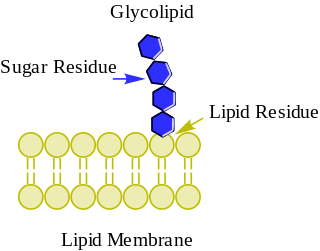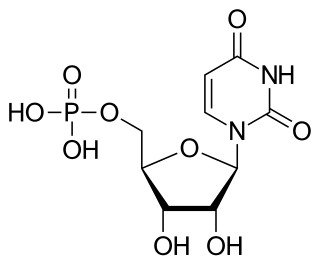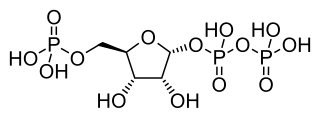Related Research Articles

Biochemistry or biological chemistry is the study of chemical processes within and relating to living organisms. A sub-discipline of both chemistry and biology, biochemistry may be divided into three fields: structural biology, enzymology and metabolism. Over the last decades of the 20th century, biochemistry has become successful at explaining living processes through these three disciplines. Almost all areas of the life sciences are being uncovered and developed through biochemical methodology and research. Biochemistry focuses on understanding the chemical basis which allows biological molecules to give rise to the processes that occur within living cells and between cells, in turn relating greatly to the understanding of tissues and organs, as well as organism structure and function. Biochemistry is closely related to molecular biology, which is the study of the molecular mechanisms of biological phenomena.

Acetyl-CoA is a molecule that participates in many biochemical reactions in protein, carbohydrate and lipid metabolism. Its main function is to deliver the acetyl group to the citric acid cycle to be oxidized for energy production. Coenzyme A consists of a β-mercaptoethylamine group linked to the vitamin pantothenic acid (B5) through an amide linkage and 3'-phosphorylated ADP. The acetyl group of acetyl-CoA is linked to the sulfhydryl substituent of the β-mercaptoethylamine group. This thioester linkage is a "high energy" bond, which is particularly reactive. Hydrolysis of the thioester bond is exergonic (−31.5 kJ/mol).

Anabolism is the set of metabolic pathways that construct molecules from smaller units. These reactions require energy, known also as an endergonic process. Anabolism is the building-up aspect of metabolism, whereas catabolism is the breaking-down aspect. Anabolism is usually synonymous with biosynthesis.
In polymer science, the polymer chain or simply backbone of a polymer is the main chain of a polymer. Polymers are often classified according to the elements in the main chains. The character of the backbone, i.e. its flexibility, determines the properties of the polymer. For example, in polysiloxanes (silicone), the backbone chain is very flexible, which results in a very low glass transition temperature of −123 °C. The polymers with rigid backbones are prone to crystallization in thin films and in solution. Crystallization in its turn affects the optical properties of the polymers, its optical band gap and electronic levels.
In chemistry, hydroxylation can refer to:

Proteoglycans are proteins that are heavily glycosylated. The basic proteoglycan unit consists of a "core protein" with one or more covalently attached glycosaminoglycan (GAG) chain(s). The point of attachment is a serine (Ser) residue to which the glycosaminoglycan is joined through a tetrasaccharide bridge. The Ser residue is generally in the sequence -Ser-Gly-X-Gly-, although not every protein with this sequence has an attached glycosaminoglycan. The chains are long, linear carbohydrate polymers that are negatively charged under physiological conditions due to the occurrence of sulfate and uronic acid groups. Proteoglycans occur in connective tissue.

Thiamine pyrophosphate (TPP or ThPP), or thiamine diphosphate (ThDP), or cocarboxylase is a thiamine (vitamin B1) derivative which is produced by the enzyme thiamine diphosphokinase. Thiamine pyrophosphate is a cofactor that is present in all living systems, in which it catalyzes several biochemical reactions.

Glycolipids are lipids with a carbohydrate attached by a glycosidic (covalent) bond. Their role is to maintain the stability of the cell membrane and to facilitate cellular recognition, which is crucial to the immune response and in the connections that allow cells to connect to one another to form tissues. Glycolipids are found on the surface of all eukaryotic cell membranes, where they extend from the phospholipid bilayer into the extracellular environment.
In organic chemistry and biochemistry, a side chain is a chemical group that is attached to a core part of the molecule called the "main chain" or backbone. The side chain is a hydrocarbon branching element of a molecule that is attached to a larger hydrocarbon backbone. It is one factor in determining a molecule's properties and reactivity. A side chain is also known as a pendant chain, but a pendant group has a different definition.

Uridine monophosphate (UMP), also known as 5′-uridylic acid, is a nucleotide that is used as a monomer in RNA. It is an ester of phosphoric acid with the nucleoside uridine. UMP consists of the phosphate group, the pentose sugar ribose, and the nucleobase uracil; hence, it is a ribonucleotide monophosphate. As a substituent or radical its name takes the form of the prefix uridylyl-. The deoxy form is abbreviated dUMP. Covalent attachment of UMP is called uridylylation.

Phosphoribosyl pyrophosphate (PRPP) is a pentose phosphate. It is a biochemical intermediate in the formation of purine nucleotides via inosine-5-monophosphate, as well as in pyrimidine nucleotide formation. Hence it is a building block for DNA and RNA. The vitamins thiamine and cobalamin, and the amino acid tryptophan also contain fragments derived from PRPP. It is formed from ribose 5-phosphate (R5P) by the enzyme ribose-phosphate diphosphokinase:
Flux, or metabolic flux is the rate of turnover of molecules through a metabolic pathway. Flux is regulated by the enzymes involved in a pathway. Within cells, regulation of flux is vital for all metabolic pathways to regulate the pathway's activity under different conditions. Flux is therefore of great interest in metabolic network modelling, where it is analysed via flux balance analysis and metabolic control analysis.
Palmitoyl-CoA is an acyl-CoA thioester. It is an "activated" form of palmitic acid and can be transported into the mitochondrial matrix by the carnitine shuttle system, and once inside can participate in beta-oxidation. Alternatively, palmitoyl-CoA is used as a substrate in the biosynthesis of sphingosine.

Dihydroorotase is an enzyme which converts carbamoyl aspartic acid into 4,5-dihydroorotic acid in the biosynthesis of pyrimidines. It forms a multifunctional enzyme with carbamoyl phosphate synthetase and aspartate transcarbamoylase. Dihydroorotase is a zinc metalloenzyme.

Orotic aciduria is a disease caused by an enzyme deficiency, resulting in a decreased ability to synthesize pyrimidines. It was the first described enzyme deficiency of the de novo pyrimidine synthesis pathway.

Nucleotidyltransferases are transferase enzymes of phosphorus-containing groups, e.g., substituents of nucleotidylic acids or simply nucleoside monophosphates. The general reaction of transferring a nucleoside monophosphate moiety from A to B, can be written as:
Donald Herman Voet was an American biochemist who was emeritus associate professor of chemistry at the University of Pennsylvania. His laboratory used x-ray crystallography to understand structure-function relationships in proteins. He and his wife, Judith G. Voet, are authors of biochemistry text books that are widely used in undergraduate and graduate curricula.

NDUFA4, mitochondrial complex associated is a protein that in humans is encoded by the NDUFA4 gene. The NDUFA4 protein was first described to be a subunit of NADH dehydrogenase (ubiquinone), which is located in the mitochondrial inner membrane and is the largest of the five complexes of the electron transport chain. However, recent research has described NDUFA4 as a subunit of cytochrome c oxidase. Mutations in the NDUFA4 gene are associated with Leigh's syndrome.

Fundamentals of Biochemistry: Life at the Molecular Level is a biochemistry textbook written by Donald Voet, Judith G. Voet and Charlotte W. Pratt. Published by John Wiley & Sons, it is a common undergraduate biochemistry textbook.
Charlotte W. Pratt is an American biochemist and author. She is the co-author with Judith G. Voet and Donald Voet of the popular standard biochemistry textbook Fundamentals of Biochemistry.
References
- ↑ Press, Jaques Cattell (1982). "American men and women of science: The physical and biological sciences".
{{cite journal}}: Cite journal requires|journal=(help) - 1 2 "Project Kaleidoscope: Judith G. Voet". Project Kaleidoscope. 8 May 2000. Retrieved 18 January 2010.
- ↑ Buehler, Lukas K. (January 2, 2000). "Reviews of books by Donald Voet, Judith Voet". Lukas K. Buehler. Retrieved 18 January 2010.
- 1 2 Wood, E.J. (1 October 1999). "Book review: Biochemistry in a nutshell - Fundamentals of Biochemistry by Donald Voet, Judith G. Voet and Charlotte W. Pratt". Trends in Biochemical Sciences. 24 (10): 409–410. doi:10.1016/S0968-0004(99)01447-4.
- 1 2 "Biochemistry and Molecular Biology Education (BAMBED), a Journal for University, College, and High School Educators by Judith G. Voet1 and Donald H. Voet2, BAMBED Co-Editors-in-Chief" (PDF). Protein Databank Newsletter. RCSB PDB (38): 5. Summer 2008.
- ↑ "Penn Chemistry: Faculty Donald Voet". The Trustees of the University of Pennsylvania. 2005. Archived from the original on 11 September 2007. Retrieved 18 January 2010.